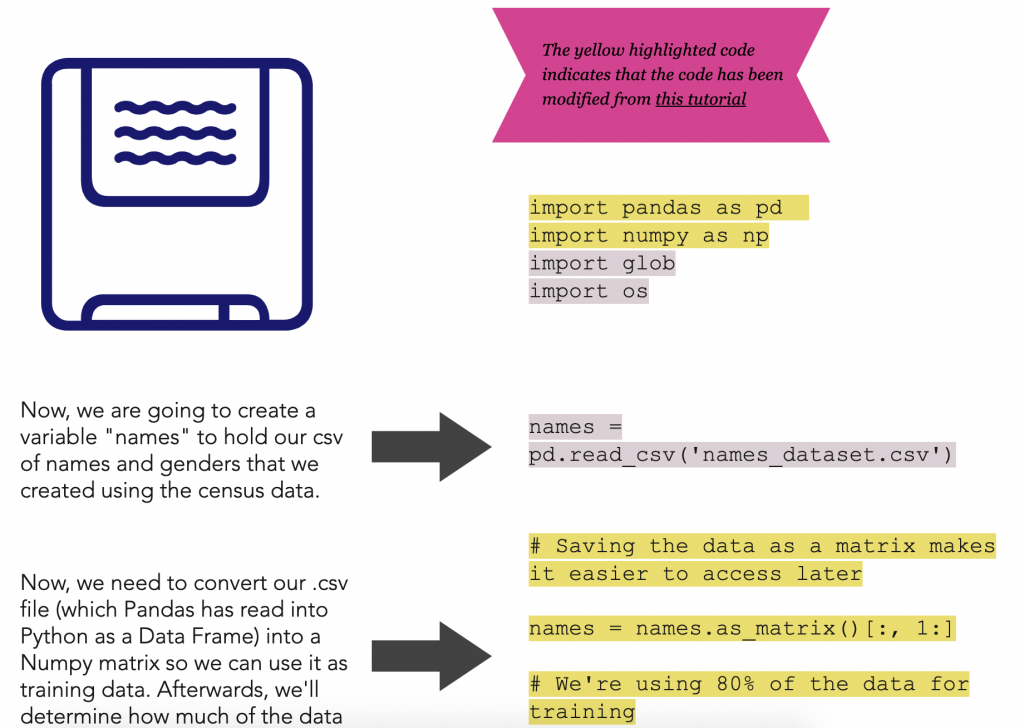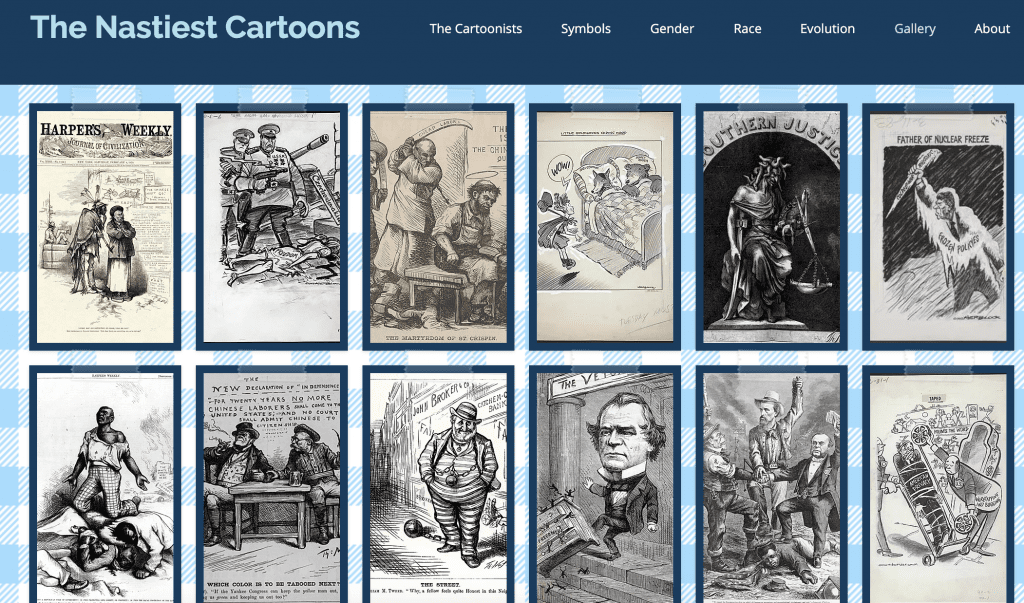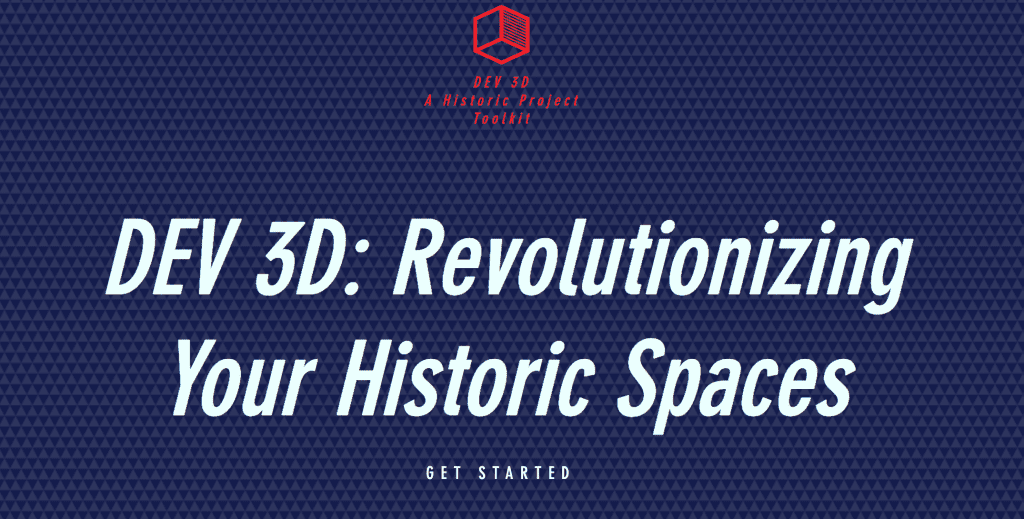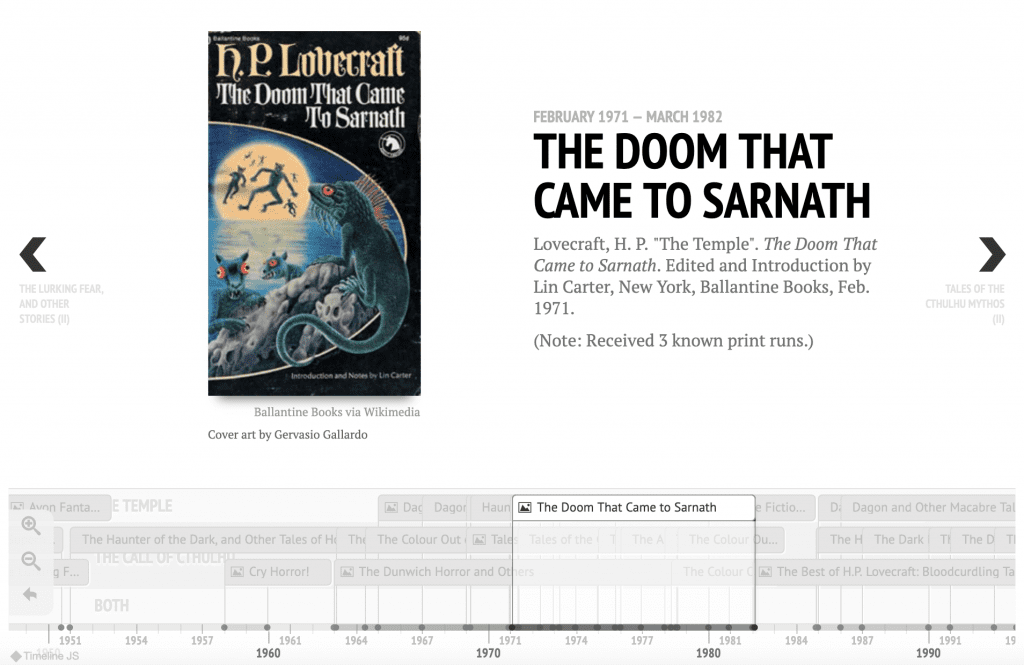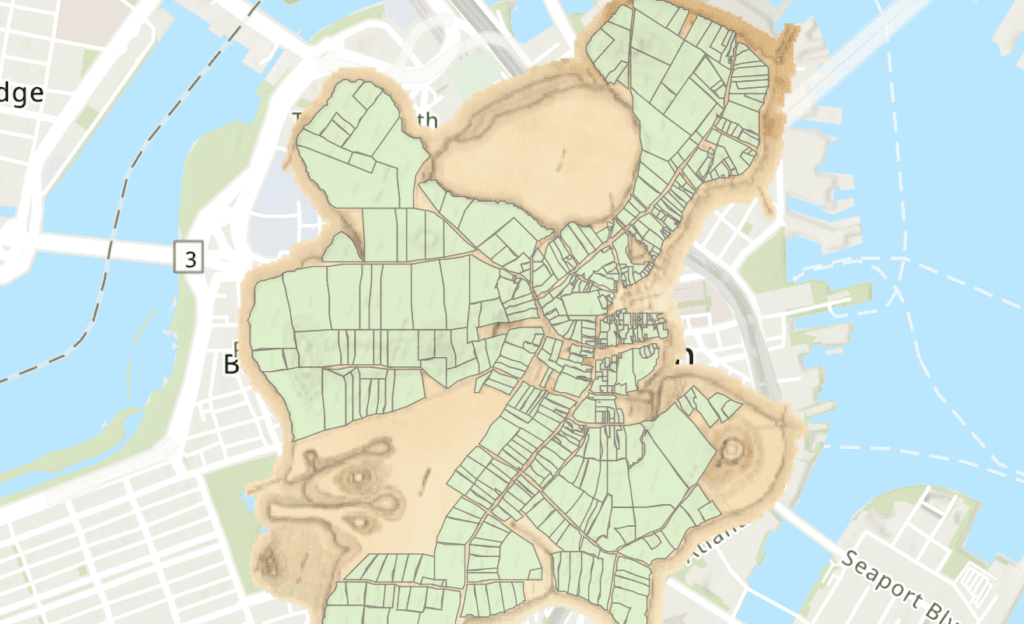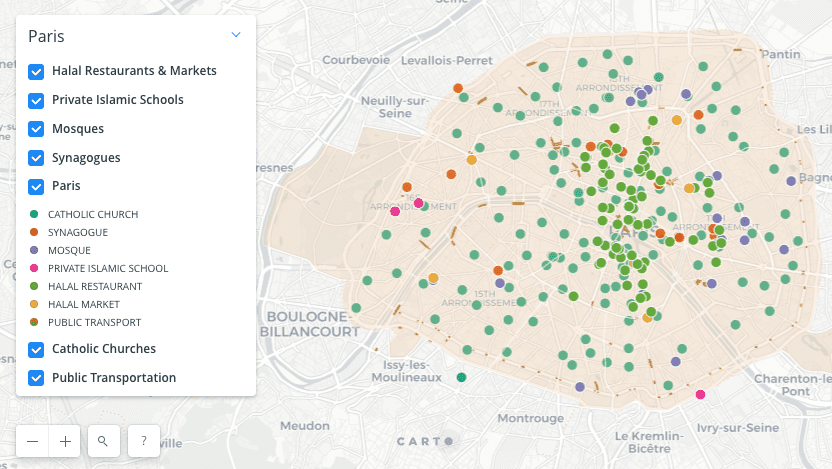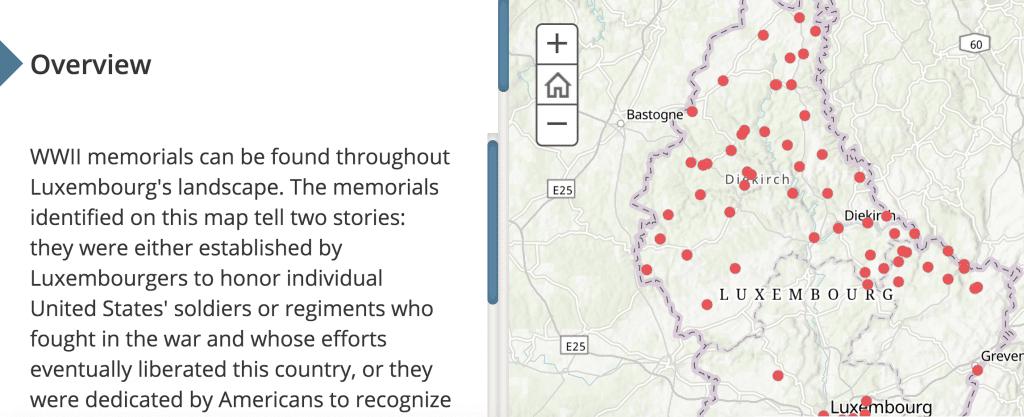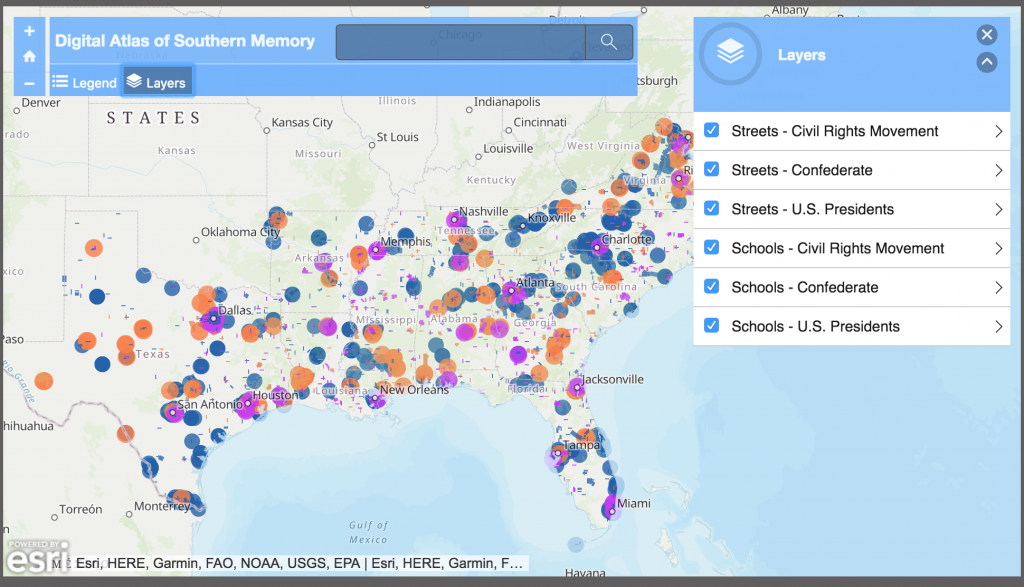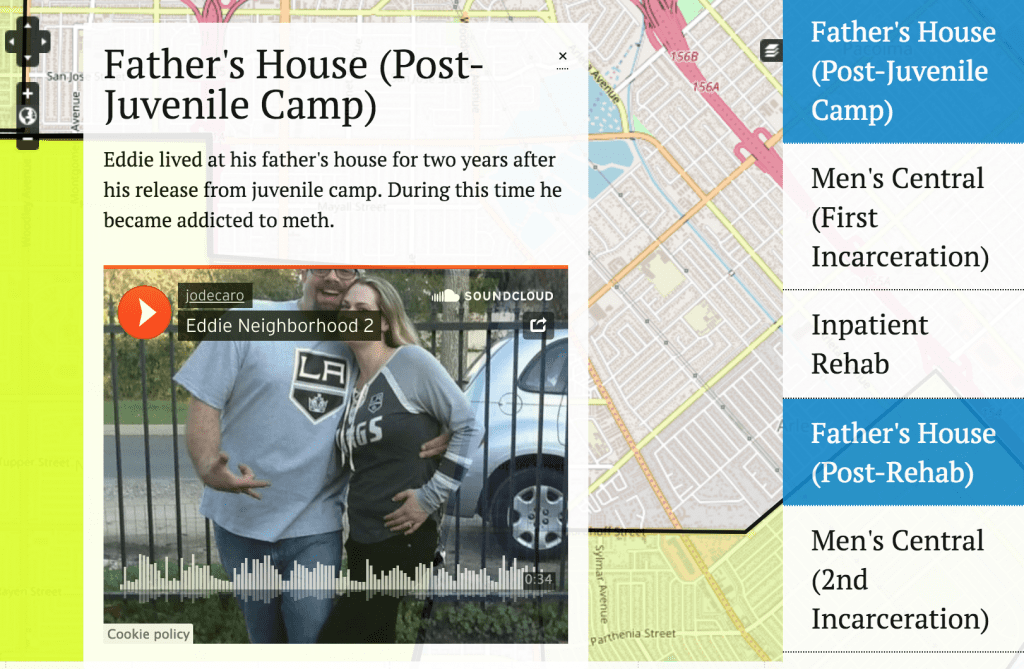
Here are some of the innovative final projects that students have completed for the DH Certificate.
Did 2020 Alternative Music Mirror the Moment?
Arielle Behar, Spring 2024
It appeared to me that 2020 was a year in which the lines between alternative and pop music seemed to blur. Thus, I decided to dig deeper into 2020, recording the U.S. events that had transpired and the corresponding U.S. alternative music. I utilized the Billboard Alternative Airplay Chart to gather the trending alternative songs in 2020. From there, I was able to record the chart peak and debut dates of each song. Subsequently, I researched the lyrics, bpm, key, songwriters, and producers of the songs. I was hoping that this information would show me trends between the music, such as whether songs in the key of A minor tended to chart more or whether male-written songs debuted faster on the chart after release. I was also interested in seeing if the time between song release and chart debut was shorter than other years due to the increase in music consumption during lockdown. The project is an ongoing effort, so I am hoping to continue expanding its data and conducting further analysis on 2020.
View the full project, “Did 2020 Alternative Music Mirror the Moment?“

Shellshock Popular Culture Archive
Galen Bunting, Spring 2024
The controversial term shell-shock was cribbed from the lexicon of soldiers, and introduced into the clinical register in a journal article by Charles Myers in 1915. The term existed as a diagnosis for war-related neuroses and trauma. In June of 1922, the War Officer Committee of Enquiry published their report on shell-shock and its treatment during the Great War. While war poets differ in their representations of war, their shared themes reflect widespread disillusionment with their place on the Western front. I include this story in my collection “War Poetry” and digital exhibit on poetry and the emerging diagnosis of shell-shock to showcase shared messages about war, disability, and masculinity. This digital archive exists to catalogue, represent, and showcase four collections of twenty-eight items alongside one exhibit and three case studies, reflecting the influence of shell-shock, a form of trauma originating in violence and/or war, on popular culture and media following the First World War.
View the full project, “Shellshock Popular Culture Archive.”

Samantha Frost, Spring 2024
The Museums MA project is the culmination of a two semester-long digital humanities seminar at Northeastern University, created by a public history graduate student. The site is designed for high school students, undergraduates, graduate students, and early career professionals who are interested in working as public historians in small to midsize history museums, art museums, historical societies, and archives in Massachusetts. The project is scoped to include resources for those early career professionals seeking employment or schooling in Massachusetts as there are relatively few resources available to serve/support this demographic. However, while the graduate programs collection contains programs from Massachusetts colleges and universities, the remainder of the resources will be useful for anyone looking to learn more about the fields of public history and museum studies. This project also acts as a template for anyone looking to explore graduate programs and opportunities outside of Massachusetts, by serving as a community space where users can browse tags, search terms, and topics to use within their own explorations of public history opportunities.
View the full project, “Museums MA.”

Exploring Narration in Lyric Poetry
Santiago Rivas, Spring 2024
Exploring Narration in Lyric Poetry is a journey into textual modeling, data extraction, and network analysis, centered around the transfer of knowledge within a song, and a listener’s relationship to said knowledge. How do select Singers and Songwriters of the 1960s and 1970s have their narrators, speakers, and themselves transmit information to their listeners and audiences, and how and in what ways do the types of knowledge transfers affect the listener’s belief, dismissal, lack of trust, or other relationship to the information? By encoding a few of Simone’s, Dylan’s, Armatrading’s, and Croce’s songs as case studies of varying narration and encoding the nuances in narration therein, Exploring Narration in Lyric Poetry begins to examine the relationship.
View the full project, “Exploring Narration in Lyric Poetry.”

Laurel Schlegel, Spring 2024
This project hopes to create a people-first database to understand the agency and liberation of people in New Hampshire and the greater Northeast as part of the larger Recovering Black History in Keene project. The archive is filled with the names of the newspaper “subscribers”: people with the means to purchase a weekly newspaper subscription and in a position of power that allowed them to view a person as having run away from them. Recording the names of individuals whose lives and stories have historically been less privileged in the archive adds to the historical record of New Hampshire in a small but meaningful way. The ads in the Escaped Ads New Hampshire database share stories of resistance- stories that deserve to be highlighted and further understood.
View the full project, “Escaped Ads New Hampshire.”

Recovering Black History in the Monadnock Region – Keene
Ellie Witham, Spring 2024
The Recovering Black History in the Monadnock Region is a citizen-archivist project. The lead archivist, Jenna Carroll, the Director of Education at the Historical Society of Cheshire County, volunteers, and a Northeastern University-based research team are tracing the history of African Americans in the Monadnock region of New Hampshire from the 1730s to the 1930s. This site is a digital collection of material relating specifically to the Black history of Keene, a city in Cheshire County. The material has been located in regional digital and physical archives; it includes documents from censuses, vital records, newspapers, probate records, family papers, etc. to identify Black individuals and experiences in 19th century Keene.
View the full project, “Recovering Black History in the Monadnock Region – Keene.”

Ayah Aboelela, Spring 2023
Muhaddithat is the Arabic term for women scholars of hadith (verbal and practical teachings), whose work and lives are here emphasized in the data sheets and graphs. Although muhaddithat make up a minority in hadith scholarship, their role has had a lasting, integral impact. By creating open access datasheets specific to the muhaddithat, their teachers, students, and teachings, as well as visualizing their scholarly relationships and teachings in the form of a network graph, this project not only affirms the role they have played in Islamic scholarship since its earliest times, but it also uncovers the nuances of their roles–the kinds of people they taught and learned from, the trends in the types of hadiths they narrated, the cities in which their scholarship thrived the most, and so on.
View the full project here.
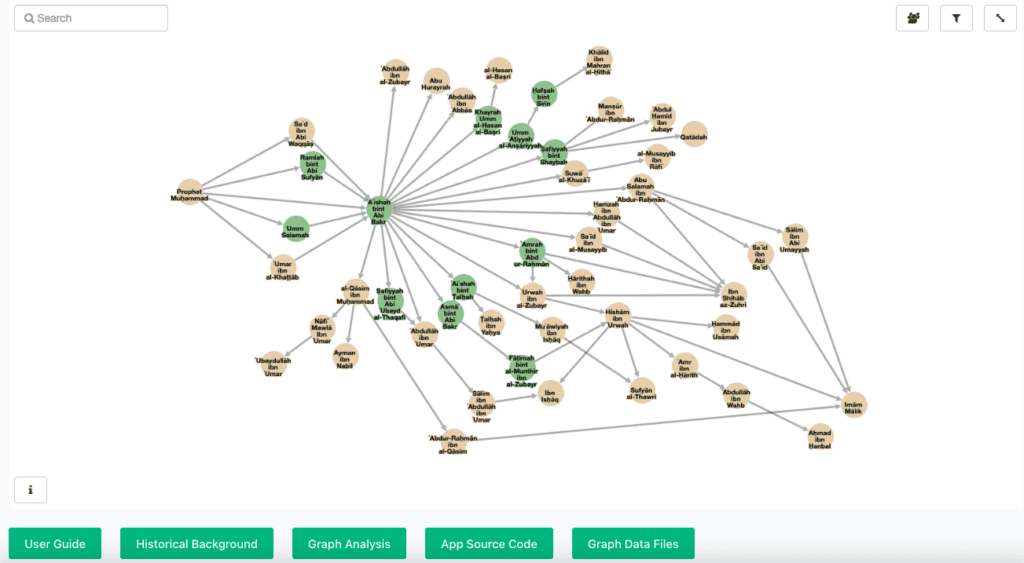
Zahra Aliyeva, Spring 2023
The region of the Caucasus lying between the Black and Caspian seas has a very diverse population in terms of the languages, ethnic groups, and religions. From ancient times it has been of interest to historians and especially linguists. This research project visualizes and analyzes the sociolinguistic situation in the region of the Caucasus from the emergence of the Soviet period in 1922 to our present days. The ultimate goal of the project is to demonstrate the ways in which the Soviet policies towards the titular and minority languages and ethnic groups contributed to the current sociolinguistic situation.
View the full project here.
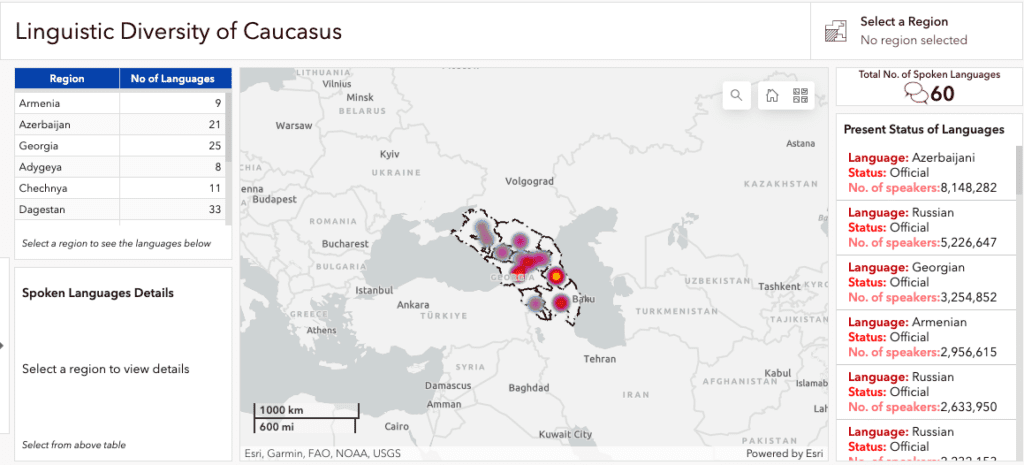
Erin Carr, Spring 2023
Zonian Incarceration is a digital archive which seeks to understand patterns of incarceration at Gamboa Prison in the Panama Canal Zone in the first half of the 20th century. The project includes a data set containing the demographic information of 56 men incarcerated at Gamboa when the 1940 census was taken. The data is comprised of basic information included in the census (name, age, race, marital status, highest level of education achieved) as well as information gathered from research undertaken to supplement the basic information included in the census (such as known aliases and the crime for which they were accused).
View the full project here.

The Rhetoric of Antislavery Project
Zobeida Chaffee-Valdes, Spring 2023
This project aims to use text analysis methods to complete a distant reading of a small corpus of abolitionist speeches delivered in 19th century Boston. Through using methods including word vector analysis and topic modeling, it will be able to find patterns in the ways Boston abolitionists spoke of slavery, abolition, citizenship, and patriotism. Factors include race of the orator, the space in which the speech was given, the occasion warranting a speech, and the time frame. While these findings will not be in any way conclusive or representative of abolitionist rhetorical trends as a whole (given my limited scope, and the small size of the corpus), the project will hopefully serve as a useful proof of concept for others doing distant readings of Abolitionist rhetoric and literature.
View the full project here.
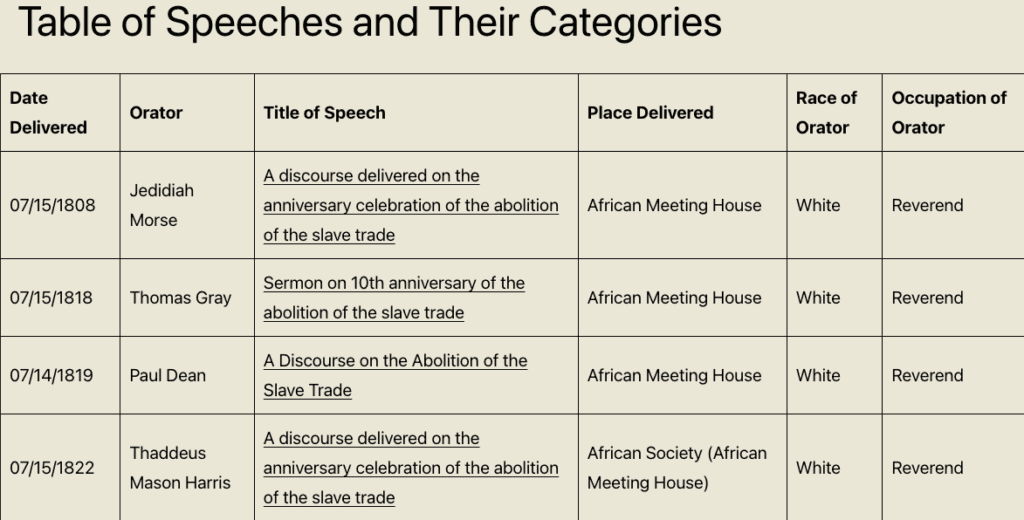
Roxanne Faure, Spring 2023
The Minimal Computing Cookbook is dedicated to documenting the development of minimal computing and inviting scholars, teachers, and students in academia and secondary education to try applying minimal computing to their own work. It’s primary goals are to 1) Be a welcoming and clear starting point for scholars, teachers, and professionals who are interested in minimal computing but may not know where to begin implementing it, 2) Provide a record of minimal computing scholarship and projects up to the present, so that visitors to the site can get a sense of what has been accomplished thus far, and 3) Model the process of learning about minimal computing as a beginner and building a minimal computing project.
View the full project here.
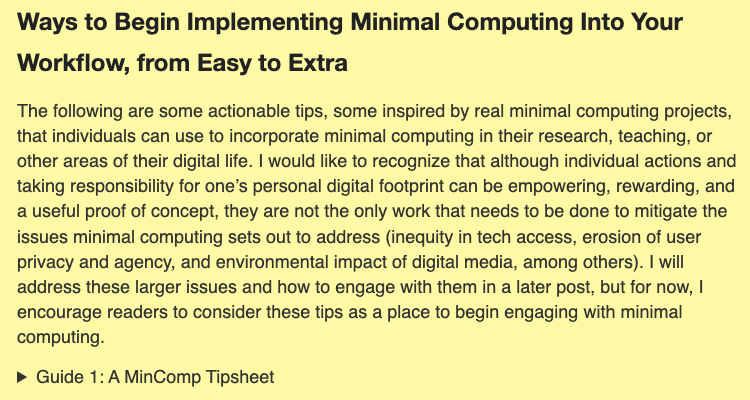
Connecticut Woman Suffrage Association Network
Avery Ferro, Spring 2023
This project was born from many hours in the archives sifting through documents relating to women’s work during World War I and the Connecticut Woman Suffrage Association. The original purpose of this archival exploration was to study the connection between women’s work and organization’s fight for woman’s suffrage. However, as this connection emerged, so did a seemingly tangled web of committees within the organization. The project therefore expanded, rounding up all the committees and the women who made them up, untangling the web of names, subcommittees, and connections, and producing a visualization of the inner-workings of the Connecticut Woman Suffrage Association. Hopefully, this data and the visual network it produces will help scholars and create a better understanding of how the CWSA understood not only itself as an organization but how it fit into the larger, nationwide fight for woman’s suffrage.
View the full project here.

The General Relief Committee of New York Project
Anna Halgash, Spring 2023
The General Relief Committee of New York formed to collect American donations for the Irish Famine (1845-1852), which were then to be processed by the Society Of Friends (Quakers) in Dublin. This project investigates the donation patterns of the GRC’s first month of monetary donations (excluding food and provisions). International aid for the Irish Famine is a neglected historical subject, and American aid was especially intriguing considering the nation’s close connection to Ireland due to the significant amount of Irish immigration even before the Famine. By analyzing the initial donations of the GRC, this project explores how data visualizations and quantitative data can reveal trends and patterns of identity that strengthen scholarship that otherwise focuses on event summary and themes.
View the full project here.

The Battle of the Bogside in Three Parts
Kasya O’Connor Grant, Spring 2023
This project maps the three days of unrest that came to be known as the ‘Battle of the Bogside,’ a major flaspoint of the Northern Irish Civil Rights movement. Its various plotted points provide information about the ways in which the Bogside residents, RUC, and British military interacted.
View the full project here.
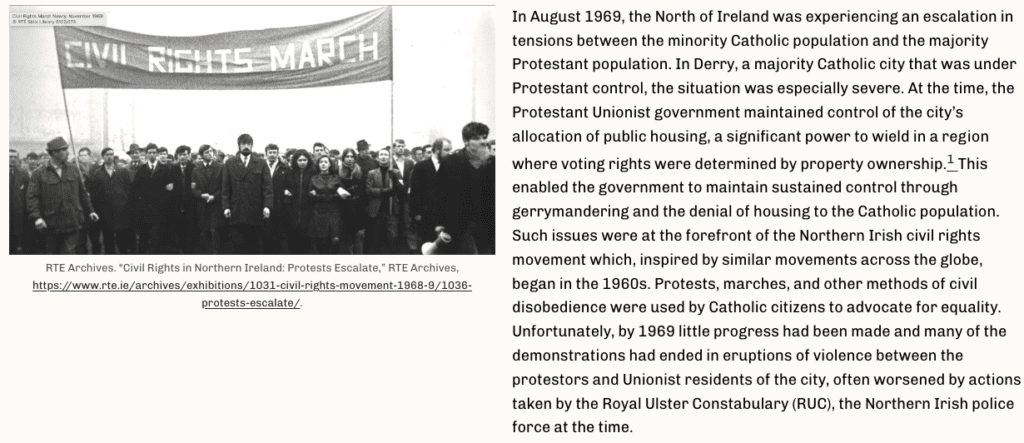
The Unfinished History Podcast
Catarina Tchakerian and Claire Lavarreda, Spring 2023
The key American tenets of liberty and equality have historically been withheld from certain citizens, a fact established early on in the creation of the new republic. Through an analysis of three broad categories – LGBT+, BIPOC, and Women’s History – The Unfinished History Podcast maintains that underrepresented communities played a significant role in the era of the American Revolution. Through six carefully crafted episodes featuring historical content and expert interviews, as well as digital creations and shout-outs supporting professional and amateur digital work, The Unfinished History Podcast seeks to contribute to scholarship that aims to fill the gaps in the historical narrative, especially those relying upon ‘the digital’ as a metric of analysis.
View the full project here.
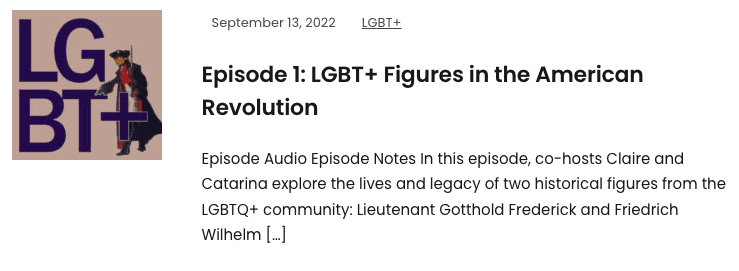
Benjamin Federlin, Spring 2022
Shadows of Norumbega is a historical mapping project that charts the nineteenth-century commemoration of Leif Erikson and the imagined Viking city of Norumbega by the Harvard chemist Eben Horsford. The project shows Horsford’s role in preserving crackpot theories among Boston elites that Norse explorers settled in New England, and visualizes the locations of the monuments that Horsford commissioned and paid for along the Charles River. It also maps other monuments in Boston, giving information on their funding and construction to pose questions about who has financed these public monuments, and how that has shaped whose history is commemorated.
View the full project here.
View the Boston Statues and Monuments map here.
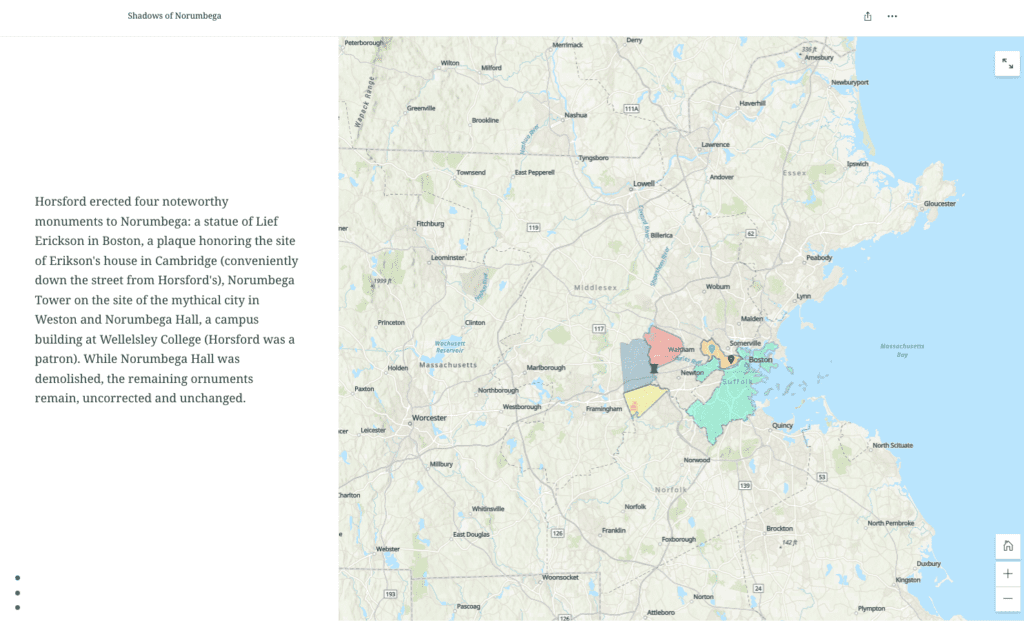
The Digital Narratives of the #BlackLivesMatter Movement Archive
Taryn Gilligan, Spring 2022
The Digital Narratives of the #BlackLivesMatter Movement Archive compiles digital personal narratives and community stories through the lens of Twitter and Instagram. The project juxtaposes personal narratives, community formation, and the rise of multimedia socio-political movements alongside performative activism, slacktivism, white saviorism, and counter protests to uncover how this kind of commandeering impacts the movement the the activists behind it. Users can browse items and collections within the archive, or search them using keywords and tags. A reading list for the project is hosted on a notion site.
View the full project here.
View the project reading list here.
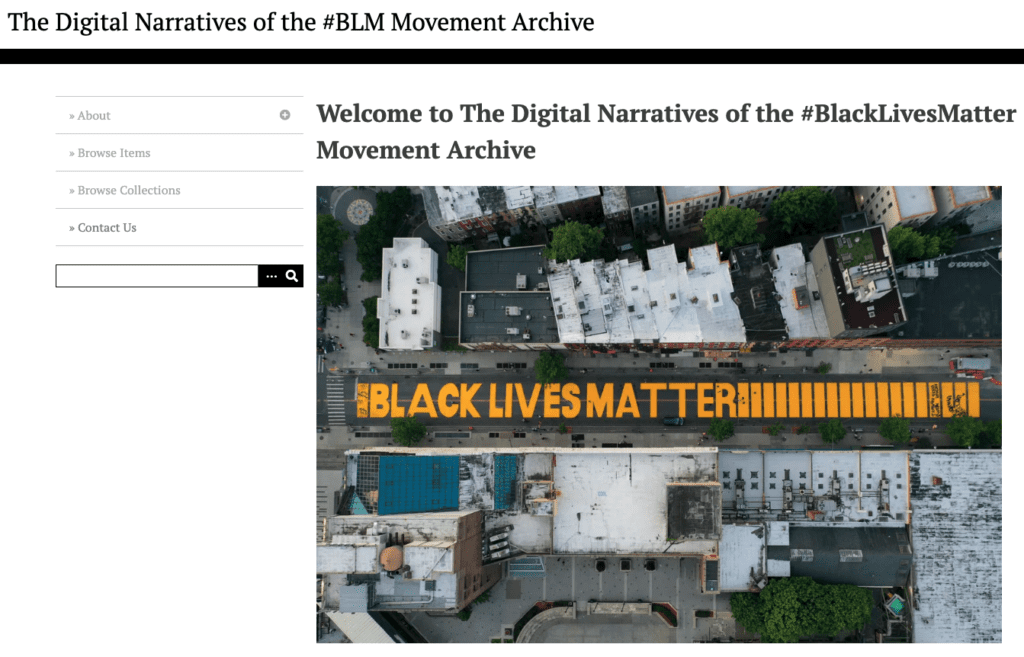
Violence, Exploitation and Death: Working Conditions at the Turn of the Twentieth Century
Paul Martin, Spring 2022
Violence, Exploitation and Death is a Twine project that examines the working class conditions of America in the late nineteenth and early twentieth century. Users navigate chapters that center different aspects of working class life, and make choices that illuminate the history of the American working class. Although the game features fictional characters, their experiences are based on real historical events and trends.
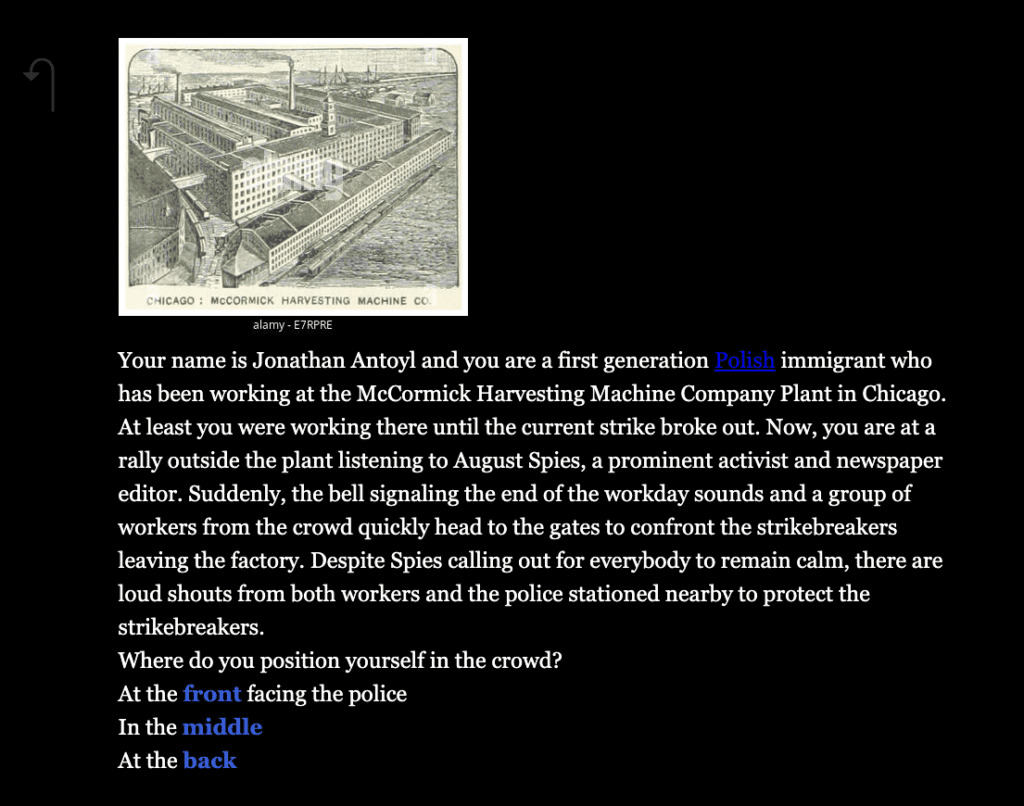
Mexican Textile Factories: 1843-1857
Hunter Moskowitz, Spring 2022
This digital history project exhibits data from textile factories in Mexico from 1843 to 1857. Users can access and manipulate the data in order to better understand the development of the Mexican textile industry in the 19th century. The database is presented alongside a historical narrative that contextualizes the data, as well as some visualizations as examples of how the data might be used. All the data is downloadable for researchers and students.
View the full project here.

Clare Nelson, Spring 2022
Everything Museums is a website featuring hand-selected, individually curated resources for public historians, museum professionals and leaders of small- to medium-sized museums. It is a repository of information about museum administration, collections management, museum outreach and education initiatives, and professional organizations and publications, all of which are accompanied by pithy evaluations of their merits. There is also a glossary of terms and a guiding overview to help users navigate the website.
View the full project here.
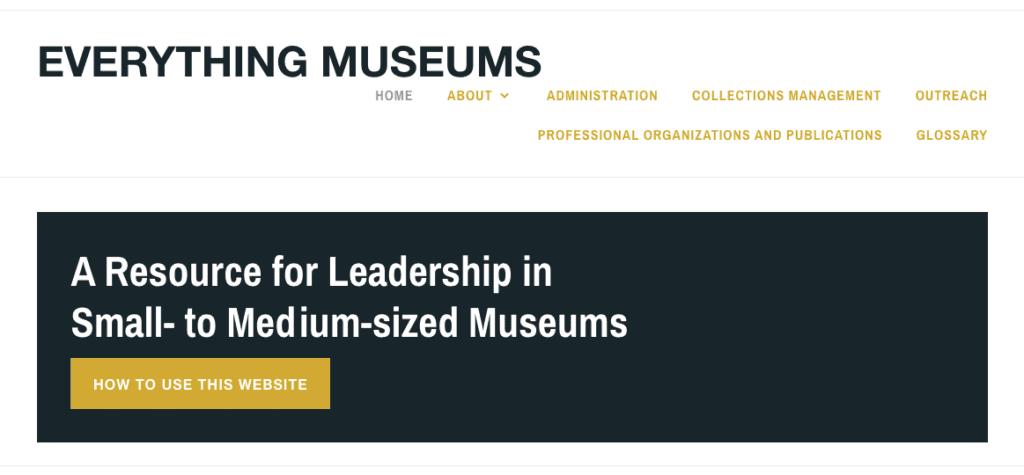
Urmi Parekh, Spring 2022
Decolonizing The Syllabus interrogates the composition of curricula from Northeastern University’s graduate English program to determine whether studied communities have been subjectivized, or whether they have been given agency to participate in the discourse. Drawing on a collection of syllabi from Northeastern’s English Department, the project focuses on the diversity of authors of assigned readings, how this has changed over time, and how authors from marginalized communities can be incorporated into reading lists. The metadata from these syllabi are organized and visualized in different ways to evidence how certain groups are privileged in English curricula.
View the full project here.

Following “The North Star”: Exploring an Abolitionist Newspaper
Alex Bice, Spring 2021
Following “The North Star” is a digital history project focusing on the abolitionist newspaper The North Star. The North Star was one of the most well know abolitionist papers of its era. Edited by Frederick Douglass, and briefly co-edited by M.R. Delany, it served as a major mouthpiece for the abolitionist movement. The paper called for an end to the oppression of African Americans in the United States, and used the language of the Declaration of Independence and other sources to argue that equality was an important but unfulfilled part of the American political tradition that began with the Revolution. This project attempts to look at how Douglass and Delany engaged in this task, including what rhetorical tools and arguments they employed.
View the full project here.
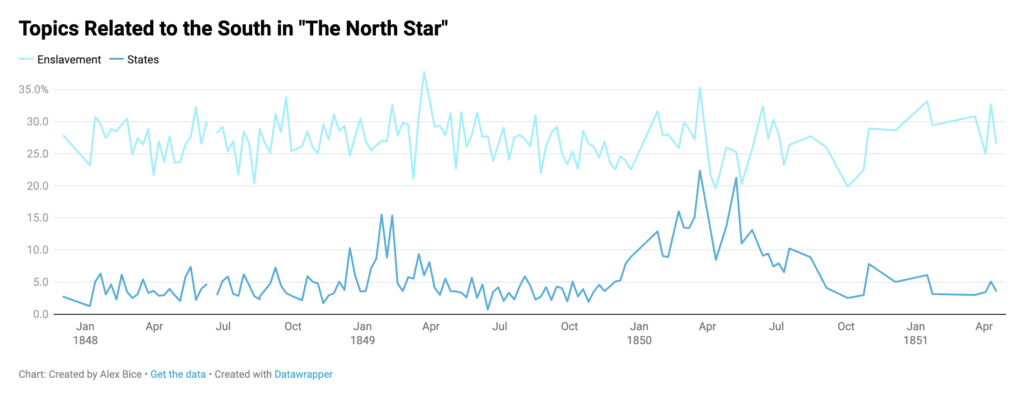
The Cold War and Word Embeddings: Exploring Gender in the FRUS Series, 1945-1968
Cassandra Cloutier, Spring 2021
This project explores the language used by State Department officials during the Cold War. By isolating the documents concerning Latin American nations during the early years of the Cold War, this project seeks to examine how the State Department regarded gender within the Western hemisphere between 1945-1968.
View the full project here.

The Women of the OSS and SOE: Counter Archives, War Intelligence, and Narrative Building
Anjelica Oswald, Spring 2021
This project aims to showcase different ways that archival research can be presented digitally. It presents new ways to understand history by engaging with archiving and narrative storytelling. This project specifically features research on the women of both the Special Operations Executive (SOE), Britain’s espionage organization, and the United State’s Office of Strategic Services (OSS), the precursor organization to the CIA. The historical implications of women in intelligence roles are not always apparent. Though this project is not all-encompassing, this site shows examples of how widespread these espionage organizations were throughout the world and just how active women were involved, both in the office and in the field.
View the full project here.
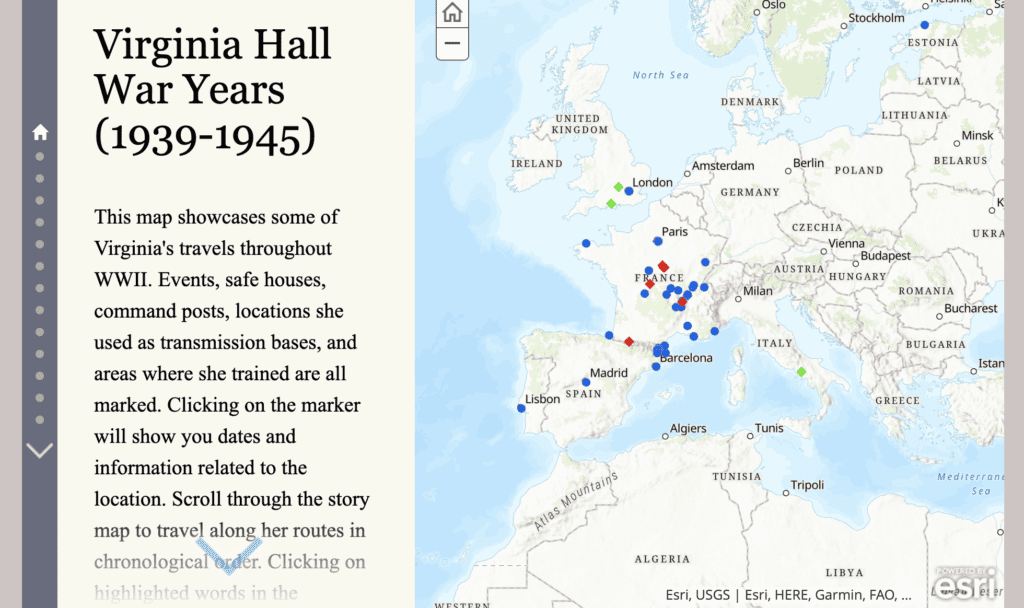
Riots or Rebellions: Teaching Boston’s Racial Unrest
Danielle Rose, Spring 2021
Americans have protested against injustice for centuries. When the protests turn violent, different terms are often used to classify them: civil unrest, riots, disorders, and rebellions, to name a few. What determines which term is used? Oftentimes, it is the race of those protesting. According to historian Jack Schneider, history has shown that white citizens who rise up against tyranny or inequality are honored as heroes or patriots. Conversely, when people of color do the same, they are usually labeled as rioters or troublemakers. These misnomers are generally perpetuated through mainstream media coverage that tends to focus more on the protest tactics and violence, rather than the underlying issues of the social movements themselves. Furthermore, scholars cite lack of diversity in news organizations, as well as biases against protests that do not follow the status quo, as some of the main reasons for inadequate—and at times, inaccurate—coverage of race-related protests. This, in turn, contributes to the delegitimization of the larger movements. The main goal of this project is to contribute to the larger discussion of how race-related protests are covered in newspapers and perceived by the general public.
View the full project here.

Stone Journal Text Analysis Project
Alicia Svenson, Spring 2021
The goal of this project is to explore the use of text analysis tools on scanned primary source journals that have been processed with optical character recognition (OCR) to see what kind of useful information can be obtained through these methods and how helpful this process can be as a research tool. This project is driven by questions of how employers within the stone industry approached workplace safety, health, and environmental issues. Are changes visible within the written record of the stone industry’s general publications? Was it a serious concern that was discussed between multiple employers within the industry or did these discussions not get a lot of attention in the general record?
View the full project here.

Disability Media Archive
Meg Szydlik, Spring 2021
This archive was particularly inspired by the controversy over Bryan Cranston taking the role of a disabled person in a film. As a disabled person, Meg was actively against this decision and was seeing a lot of articles with wildly different opinions. However, Meg also noticed that a lot of these articles were not written by disabled people, but still purported to speak for them. Therefore, Meg decided to explore content that was written by disabled people about representation of disability in the media.

Topic Modeling Headline News About the Anti-Vietnam War Movement, 1964-1966
Adam Tomasi, Spring 2021
This project is a topic model of headline news coverage about the anti-Vietnam War movement between 1964 and 1966. Headline news shaped how a reading public understood the anti-Vietnam War movement at this time. Unlike editorials or advertisements that have a more obvious bent, headline news is ostensibly an imminent, neutral recounting of past events. But headline news is not neutral; journalists have to make choices about the selection, arrangement, and prioritization of data, which shapes the topics represented in the corpus.
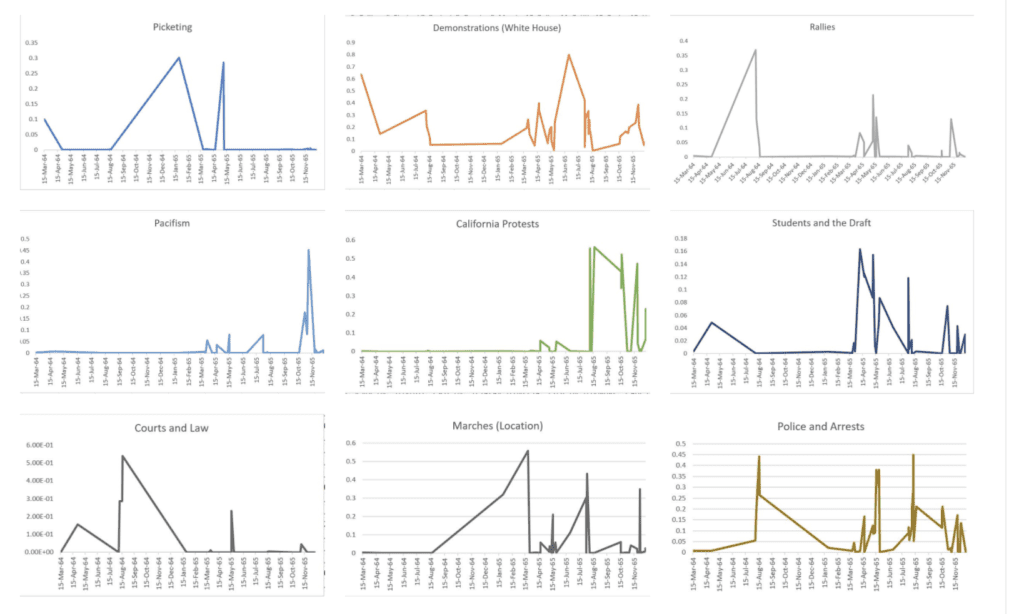
Avery Blankenship, Spring 2020
Coding the Bechdel Test is a comprehensive tutorial for developing a computational version of the Bechdel Test for nineteenth-century novels. Because this tutorial is invested in feminist coding practices, it does not assume that this code or this version of the test is the only solution that works, or works in the best way. As a result, users are invited to edit the code and try different methods for improving on this test. The code for this tutorial will be available as a Jupyter Notebook on Github and if any improvements are made to the code, users are encouraged to submit their improvements. This tutorial is deeply invested in feminist practice and inclusivity and welcomes feedback on the language of the tutorial as well as accessibility of material.
View the full project here.
remiXML: Incorporating XML in First Year Writing
Cara Marta Messina, Spring 2020
This project merges interest in fan studies, critical pedagogy, and DH by building an XML (extensible mark-up language) schema that asks student writers to remix shared readings and their peers’ texts. This schema, called the remiXML, is broken up into three sections: the metadata (descriptions of the file, author, remixer, and title), the original text (either the shared reading or a student writers’ assignment), and the play section (where the student writers create their interventions about the text).
View the full project here.
Mahala Nyberg, Spring 2020
Behind the Blue Line is a collection of exploratory maps that investigates the experiences of conservation workers in the Adirondack region of New York State in the mid to late twentieth century. Through a survey of worker experiences and stories from conservation efforts in the region, an understanding of the impact of individuals on the landscape of the Adirondacks can be gained. This project also showcases the execution of conservation efforts behind the legislative decisions that have determined environmental policy in the Adirondacks and brings attention to the current environmental concerns faced by the region.
View the full project here.
Hailey Philbin, Spring 2020
The goal of this digital platform is to function as an exhibit space for some of the greatest American political cartoons. By analyzing how the interpretation of themes like racism and ethnicity, Presidential politics, gender roles, and symbols have evolved throughout modern political cartoon history, visitors to the site can learn how to decode cartoons from the past as well as today. As a demonstration of the evolution of political cartooning, this digital exhibit can function as a guide to gaining the skills it takes to understand generations of historical hilarity. This digital space will also serve to explore and describe a comprehensive evolution of modern American political cartooning by comparing the periods of work between three prolific cartoonists: Thomas Nast, Clifford Berryman, and Herbert Block.
View the full project here.
Cold War Confidential
Carly Quinn, Spring 2020
Cold War Confidential is a public history project featuring an interactive, digital, text adventure gaming experience. Acting as the US President, students will analyze top-secret documents and attempt to resolve a Cold War crisis in real-time using the gaming platform, Quest. Cold War Confidential was created to be used in conjunction with high school and college-level history curricula. A basic understanding of the Cold War is required for this project to be utilized successfully.
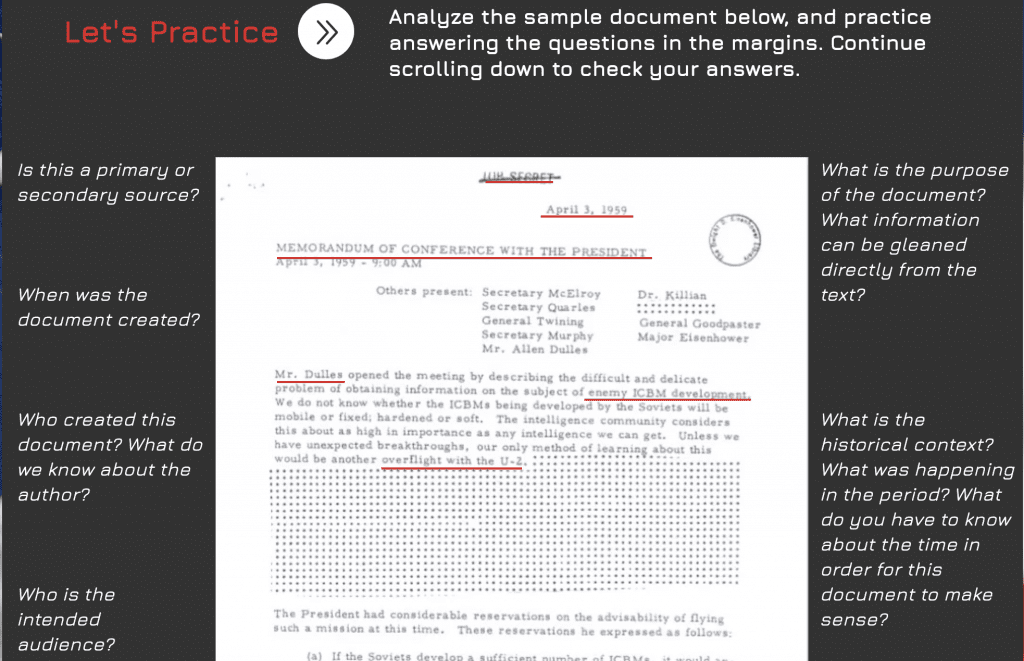
Histories or Stories? The Power of Historical Narratives
Shannon Webber, Spring 2020
Histories or Stories? is a project centered around stories included in the works of the famous New England storyteller Edward Rowe Snow. The stories are a mix of both historically verifiable and non-verifiable accounts. Each possesses extreme historical value and are worthwhile tools for the teaching of history.
View the full project here.
Megan Barney, Spring 2019
History Needs New Heroes seeks to reveal who gets presented as a “hero” in high school American history textbooks from 1945 to the present. Through close reading and content analysis of three recently published textbooks, this project identifies missing voices. As a result, this project will write new narratives on American heroes that can inspire students to find stories that they can relate to in the present day.
View the full project here.
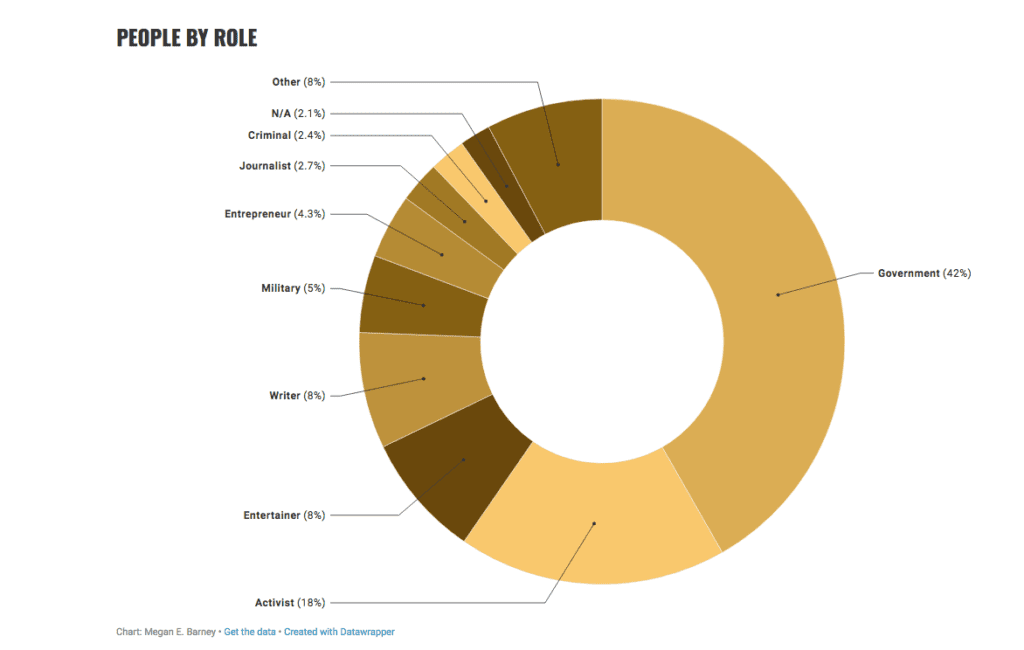
DEV 3D: A Historic Project Toolkit
Lauren Bergnes Sell, Spring 2019
Downtown Boston is brimming with historic sites and artifacts, but many of them remain inaccessible for a litany of reasons. 3D Modeling and digitization of spaces and artifacts allow greater accessibility to these spaces and artifacts that may lie behind geographical, financial, and physical barriers. This project utilizes the 18th-century tombs located beneath The King’s Chapel as a case study for exploring the role of these new technologies within exhibits and interpretive themes.
With a theoretical foundation nested in Yi-Fu Tuan’s “Space and Place: Humanistic Perspective” and 3D modeling and Public History theory, Dev 3D hopes to provide early blueprints and case studies for creating and implementing 3D models in a variety of ways within a historic/cultural space. The prototype toolkit contains a list of software, tools, and methods for constructing simple 3D artifacts that can be used to create 3D printed models, Augmented Reality apps, or digital exhibits.
View the full project here.
Rat(io)s in the Walls (of Text): An H.P. Lovecraft Digital Humanities Portfolio
Kenneth Haley, Spring 2019
In recent years there has been a renewed interest in the work of H.P. Lovecraft, and a reassessment of his place in American literary history. Once relegated to the pulp magazines of the early 20th century, the past 20 years has seen Lovecraft’s work added to publishing lines such as The Library of America, Oxford World’s Classics, and the Penguin Classics line. Meanwhile, numerous “omnibus,” “definitive,” and “annotated” editions of his work have been released from various publishers. How and why has work that was published in a cheap, disposable format survived to this day and garnered such attention?
Rat(ios) in the Walls (of Text) attempts to examine the “how” portion of that question through the application of various tools developed as part of the growing field of the Digital Humanities.
View the full project here.
Molly Nebiolo, Spring 2019
It has been difficult to visualize Boston’s early history prior to the first map of the city in 1722. In the late nineteenth-century, Boston cartographer Samuel Chester Clough attempted to remedy this problem by crafting maps of Boston using inhabitant data found in The Book of Possessions, but never completed the project. “The Birth of Boston” is a twenty-first century attempt at reviving Clough’s venture into discerning what Boston looked like and who lived there during its settlement.
“The Birth of Boston” is an interactive webmap of colonial Boston that allows users to click on land parcels to learn about each inhabitant that lived there in 1648. Clough’s maps are the basis for the geographic information we have on the land ownership of settlers, but the second resource for this digital project comes from the Annie Haven Thwing collection. At the turn of the twentieth century, Thwing researched and created a corpus detailing the lives of over 50,000 Boston inhabitants from 1630 to 1822. This database of citizen information was used to give a “face” to the names that Clough has depicted on his map.
View the full project here.
Colleen Nugent, Spring 2019
This project provides a new layer of context to the study of Muslims in France, through digital maps of the three French cities with at least 10% Muslim population. The laws regarding secularism in France, however, provided an immediate barrier to information, with a law from the late nineteenth century banning the collection of any data regarding race or religion. Therefore this project uses Islamic institutions, such as mosques, private Islamic schools, and halal restaurants and markets as a metric of potentially determining levels of assimilation. These maps also include the locations of public transportation stops, both buses and metro, with an assumption that accessibility to public transport can serve as an indicator of assimilation. For comparison, there is a comprehensive map that also depicts the locations of Catholic churches and Jewish synagogues.
View the full project here.
Katie and Megan Woods, Spring 2019
From Grateful Friends explores public memory, the ways in which a collective group remembers its past. This project’s central focus is a prototype of a map that shows the physical forms of public memory (memorials, markers, museums, and a cemetery) of World War II in Luxembourg. Luxembourgers and Americans have worked to record and preserve the stories of their shared history from this time, with their mutual feelings of gratitude still present today.
A work in progress, the map will continue to grow with the addition of new stories and sites of memory. The map is joined by other tools visitors may explore: a historical timeline, blog, and resources. Through these elements, From Grateful Friends celebrates the coming together of two countries in war and reminds us of the richness of international friendship and camaraderie.
View the full project here.
The Digital Atlas of Southern Memory
Caroline Klibanoff, Spring 2018
In an era of fervent memorialization and contentious debates about who and what should be commemorated in the public sphere, the conversation has largely been limited to physical monuments such as statues, plaques, and landmarks. These structures advance narrow cultural narratives about the past, require significant capital to establish, and allow for no interaction or annotation by the public. As a result, there is little opportunity for most Americans to participate in what gets remembered – and yet the hunger is there, visible in heated debates, defaced statues, and renamed spaces cropping up in communities across the nation.
With a theoretical underpinning in collected memory studies and public history, the Digital Atlas of Southern Memory (DASM) presents a prototype for a platform that can enable broader participation in the commemoration process. It aims to be an engine for doing what public history, at its best, should do: meet modern, digital audiences where they are; help them connect with their own history, and awaken a curiosity — and usually, an opinion — about what they hope will be remembered.
View the full project here.
Angelenos Incarcerated: The LA County Jail Oral History Project
Joanne DeCaro, Spring 2017
The LA County Jail Oral History Project aims to document the conditions, culture, and recent history of the LA County jail system through the oral histories of former and current inmates. The project wishes to create an opportunity to grant an authoritative voice to the literally disenfranchised minority of the former and current local inmate population in Los Angeles County. Five oral histories have been gathered from those who were incarcerated in one of the LA County jails from the 1980s to the present day. The project’s long-term goal is to collect 80 to 100 oral histories to form a representative sample of former and current inmates, taking into account factors such as race, gender, and sexual orientation.
The underlying philosophical goals of the project are to provide an opportunity for inmates and former inmates to create authoritative narratives of their experiences in the LA County jail system in a manner that supports inmates regaining and reimagining ownership of their life stories surrounding incarceration and to foster dialogue and understanding with the inmate community and the general public.
View the full project here.
-
Type of Program
- Graduate Certificate
-
Links and Resources
